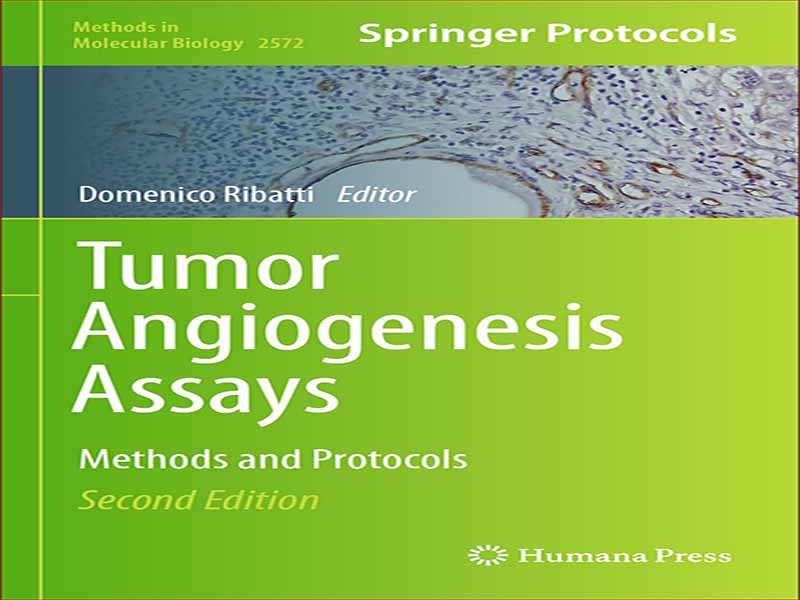- عنوان کتاب: Tumor Angiogenesis Assays
- نویسنده: Domenico Ribatti
- حوزه: زیست شناسی مولکولی, تومور
- سال انتشار: 2022
- تعداد صفحه: 216
- زبان اصلی: انگلیسی
- نوع فایل: pdf
- حجم فایل: 7.78 مگابایت
رشد تومورهای جامد و هماتولوژیک وابسته به رگزایی است. آنژیوژنز تومور یک نشانه بارز سرطان است و عموماً به عنوان پیامد یک سوئیچ رگ زایی در نظر گرفته می شود، یعنی یک رویداد ژنتیکی که به تومور توانایی جذب رگ های خونی از بافت مجاور را می دهد. با این حال، تومورها همچنین میتوانند از طریق مکانیسمهای جایگزین، از جمله رشد میکروواسکولار هضمزا، کواپشن عروقی، و تقلید عروقی رشد کنند که میتواند پاسخ بالینی ضعیف و مقاومت به درمانهای ضد رگزایی را توضیح دهد. در واقع، علیرغم کشف و توسعه عوامل ضد رگ زایی متعدد برای درمان سرطان، که اثرات مهاری امیدوارکنندهای را در آزمایشهای پیش بالینی نشان دادهاند، و در برخی موارد رگرسیون تومور، این عوامل در آزمایشهای بالینی بسیار ناامیدکننده بودهاند. بافت تومور با تکثیر سریع، افزایش نفوذپذیری و ساختار نامرتب مشخص می شود، ویژگی هایی که علت یا پیامد پرفیوژن و اکسیژن رسانی ناکافی است. چالش فنی اصلی در هر مطالعه رگزایی تومور، انتخاب مناسب ترین روش است. با وجود افزایش تعداد روشهای in vitro و in vivo، یک روش رگزایی “استاندارد طلایی” هنوز توسعه نیافته است. بنابراین، ترکیبی از سنجش برای شناسایی رویدادهای مولکولی و/یا سلولی در رگزایی تومور مورد نیاز است. ناهماهنگی دادهها نسبت به اثربخشی درمانهای ضد رگزایی، نیاز به آزمایشهای بالینی دقیق با استفاده از مدلهای مربوطه و محدودیتهای هر سنجش در نظر گرفته شده را برجسته میکند، بنابراین از تفسیر بیش از حد نتایج اجتناب میشود. درک این مکانیسم ها برای یک هدف درمانی موثر فرآیند رگ زایی بسیار مهم است. بینش بهتر در مورد مکانیسمهای مولکولی و توسعه روشهایی برای القاء و مشاهده عادی سازی عروق منجر به درمانهای قویتری برای سرطان میشود. پیشرفت های اخیر در تکنیک های میکروسکوپی همراه با تجزیه و تحلیل محاسباتی پارادایم های جدیدی را در مطالعه جریان عروقی و نفوذپذیری ایجاد کرده است. هدف ویرایش دوم این کتاب اثبات طیف وسیعی از روشها و پروتکلها برای مطالعه رگزایی تومور در شرایط in vitro و in vivo است تا پیشرفتها در این زمینه را منعکس کند. مایلم از همکارانی که با مهربانی موافقت کردند تا در تهیه این کتاب همکاری کنند تشکر کنم.
Growth of solid and hematologic tumors is angiogenesis dependent. Tumor angiogenesis is a well-established hallmark of cancer and is generally viewed as the consequence of an angiogenic switch, that is, a genetic event that endows the tumor with the ability to recruit blood vessels from the neighboring tissue. However, tumors can also grow through alternative mechanisms, including intussusceptive microvascular growth, vascular co-option, and vasculogenic mimicry, which can explain the poor clinical response and resistance to antiangiogenic therapies. In fact, despite the discovery and development of numerous antiangiogenic agents for the treatment of cancer, which have shown promising inhibitory effects in pre-clinical testing, and in some instances tumor regression, these agents have proved very disappointing in clinical trials. Tumor tissue is characterized by rapid proliferation, increased permeability, and disorganized architecture, properties which are a cause or a consequence of inadequate perfusion and oxygenation. The main technical challenge in any study of tumor angiogenesis is the selection of the most appropriate assay. Despite the increasing numbers of both in vitro and in vivo assays, a “gold-standard” angiogenesis assay has yet to be developed; therefore, a combination of assays is required to identify the molecular and /or cellular events in tumor angiogenesis. The inconsistency of data relative to the efficacy of anti-angiogenic treatments highlights the need for rigorous preclinical testing using relevant models and the limitations of each assay being taken into consideration, thus avoiding over interpretation of results. The understanding of these mechanisms is crucial for an effective therapeutic targeting of the angiogenic process. A better insight into the molecular mechanisms and development of methods to induce and observe vessel normalization will result in more potent therapies for cancer. Recent advances in microscopic techniques combined with computational analysis have created new paradigms in studying vascular flow and permeability. The aim of the second edition of this book is to prove a range of methods and protocols for studying tumor angiogenesis in vitro and in vivo to reflect advances in the field. I would like to thank the colleagues who kindly agreed to contribute to this book.
این کتاب را میتوانید از لینک زیر بصورت رایگان دانلود کنید:
Download: Tumor Angiogenesis Assays




































نظرات کاربران